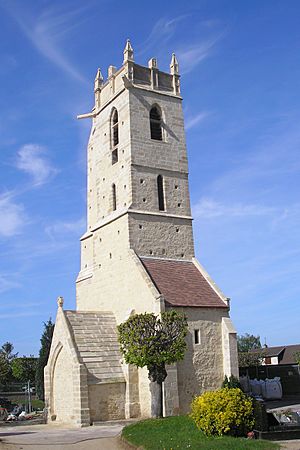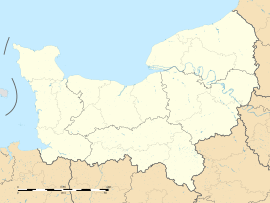Ranville facts for kids
Quick facts for kids
Ranville
|
||
|---|---|---|
|
The belltower of the church in Ranville
|
||
|
||
| Country | France | |
| Region | Normandy | |
| Department | Calvados | |
| Arrondissement | Lisieux | |
| Canton | Cabourg | |
| Intercommunality | Campagne et Baie de L'Orne | |
| Area
1
|
8.42 km2 (3.25 sq mi) | |
| Time zone | UTC+01:00 (CET) | |
| • Summer (DST) | UTC+02:00 (CEST) | |
| INSEE/Postal code |
14530 /14860
|
|
| Elevation | 1–49 m (3.3–160.8 ft) (avg. 26 m or 85 ft) |
|
| 1 French Land Register data, which excludes lakes, ponds, glaciers > 1 km2 (0.386 sq mi or 247 acres) and river estuaries. | ||
Ranville is a small village in northwestern France. It is located in the Calvados area, which is part of the Normandy region. Ranville is known for its important role in World War II.
Contents
Ranville's Role in D-Day
Ranville holds a special place in history because it was the very first French village to be freed on D-Day. D-Day was a huge military operation that happened on June 6, 1944. On this day, Allied forces landed in Normandy to begin taking back France from German control.
How Ranville Was Liberated
The village of Ranville was freed by brave soldiers from the British 13th Parachute Battalion. This group was led by Lieutenant-Colonel Peter Luard. These soldiers parachuted into the area to help secure key locations. After the village was liberated, a building called the château du Heaume became important. It was used as the main office for the British 6th Airborne Division.
Ranville in Books
The story of Ranville and the 13th (Lancashire) Parachute Battalion is told in a book called 13 - Lucky For Some. This book shares the history of the battalion. It includes many photos showing how the area looked then and now. The book also has maps and diagrams that explain the battles that took place nearby.
Images for kids
-
A Bailey bridge section at the Memorial Pegasus museum in Ranville
See also
 In Spanish: Ranville para niños
In Spanish: Ranville para niños









